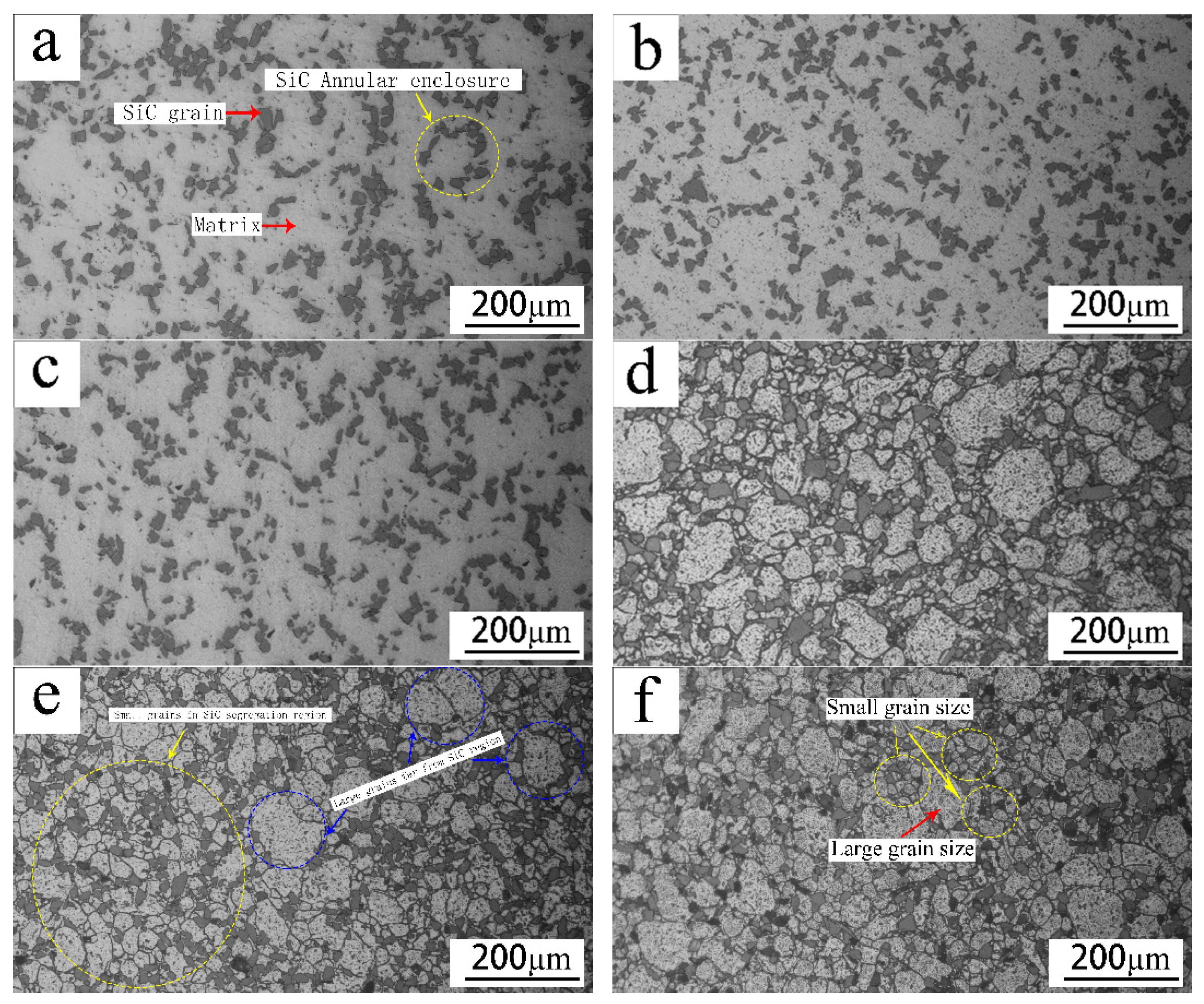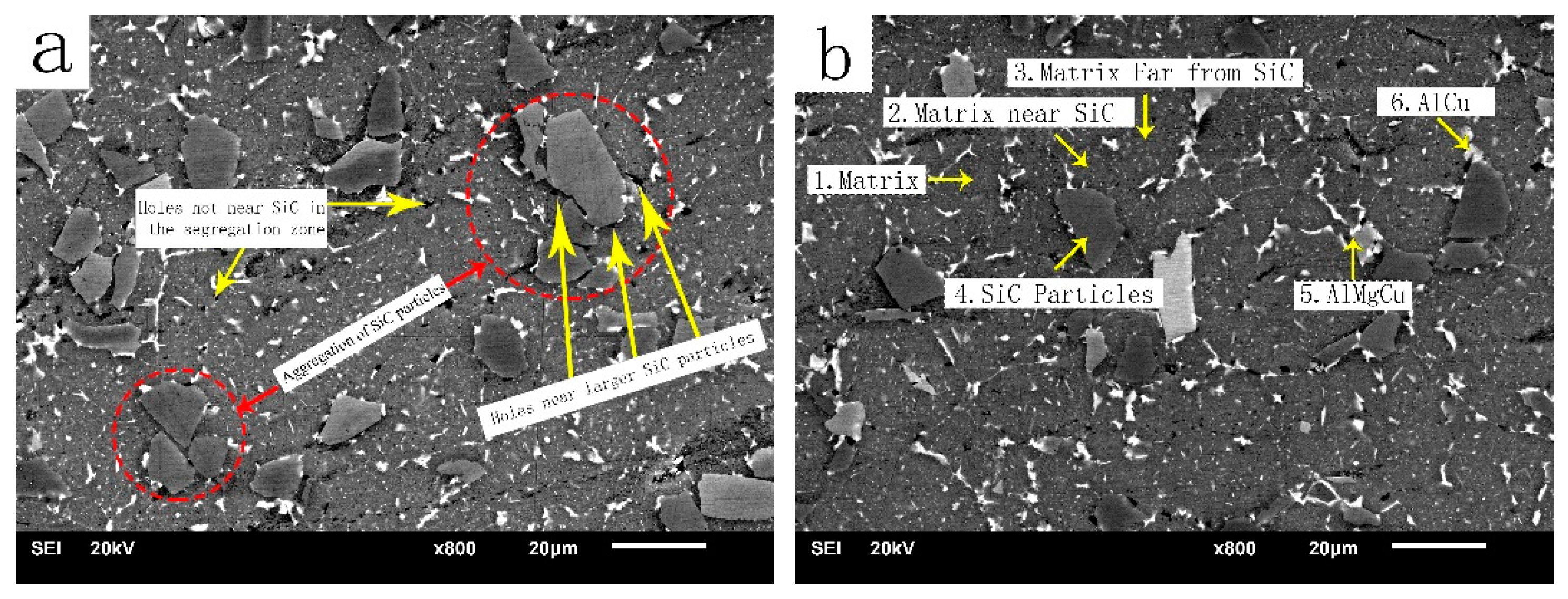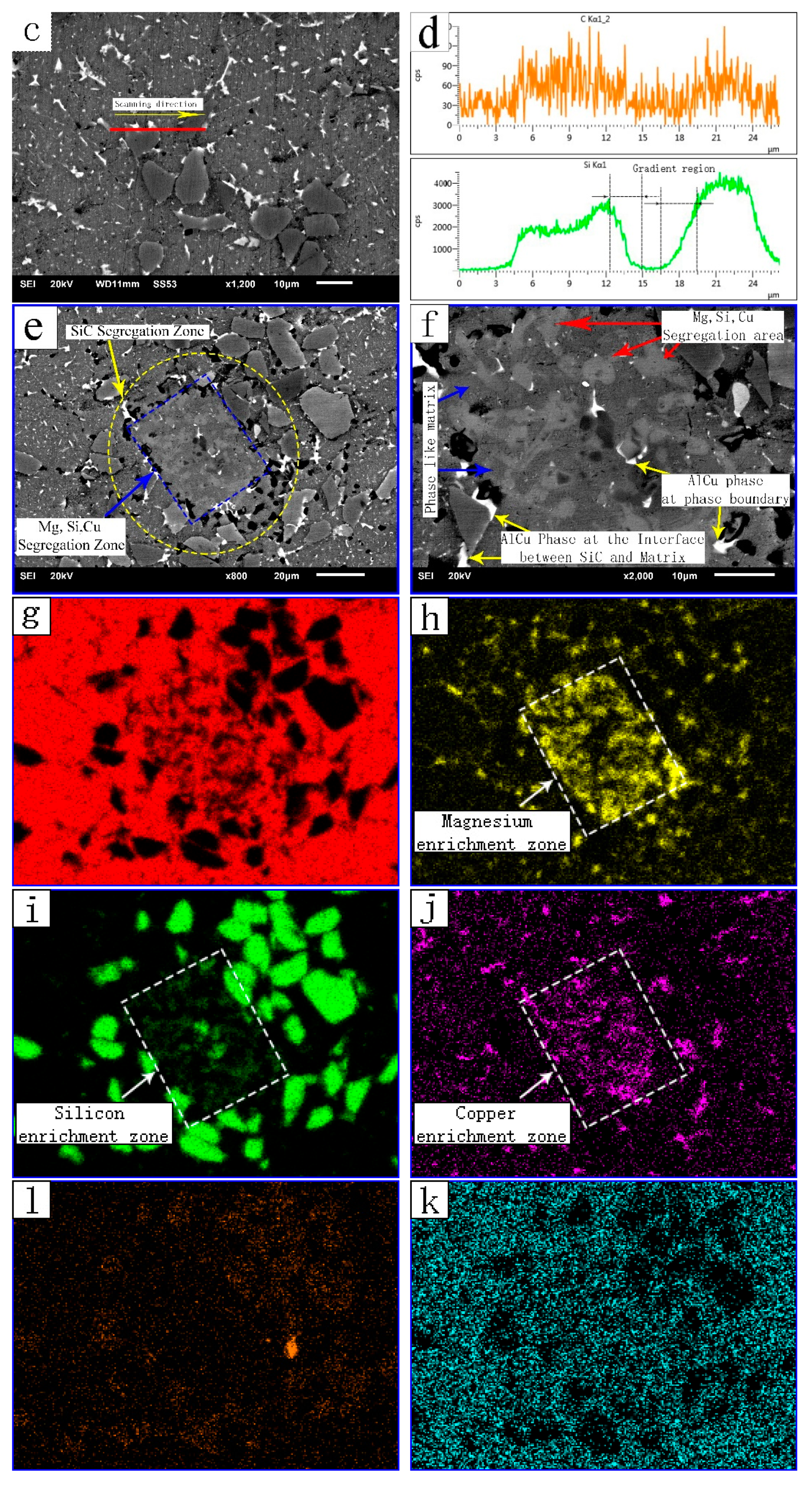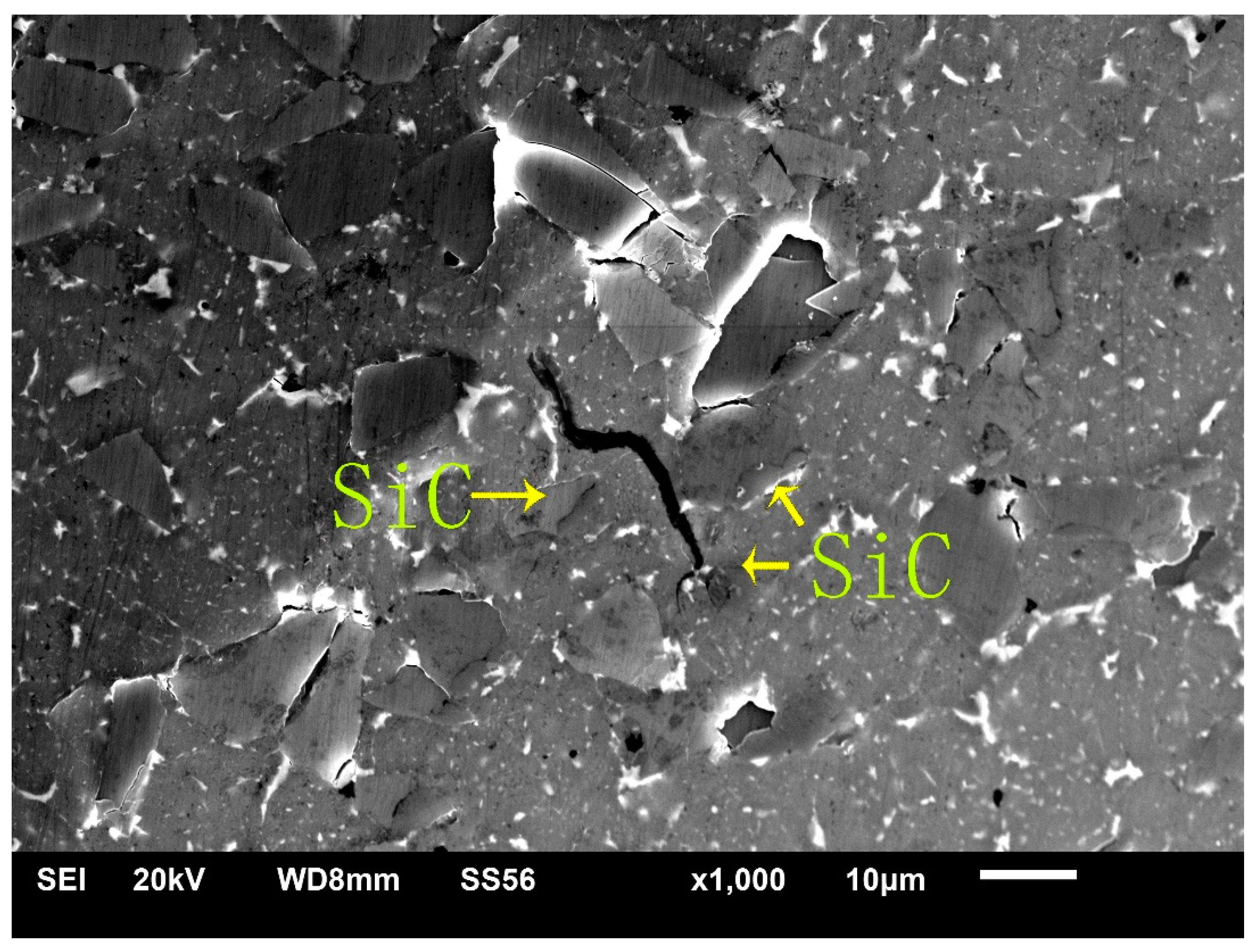Study of the Microstructure and Ring Element Segregation Zone of Spray Deposited SiCp/7055Al
Abstract
:1. Introduction
2. Experiment
3. Results and Analysis
3.1. Metallographic Microstructure Analysis
3.2. Microstructure Analysis
3.3. Mechanical Properties
4. Conclusions
Author Contributions
Funding
Conflicts of Interest
References
- Chen, C.; Guo, L.; Luo, J.; Hao, J.; Guo, Z.; Volinsky, A.A. Aluminum powder size and microstructure effects on properties of boron nitride reinforced aluminum matrix composites fabricated by semi-solid powder metallurgy. Mater. Sci. Eng. A 2015, 646, 306–314. [Google Scholar] [CrossRef]
- Sabbaghianrad, S.; Langdon, T.G. Developing superplasticity in an aluminum matrix composite processed by high-pressure torsion. Mater. Sci. Eng. A 2016, 655, 36–43. [Google Scholar] [CrossRef] [Green Version]
- Zhao, S.-L. Research of Microstructure and Properties of Spray Formed High Alloyed High Speed Steel. Ph.D. Thesis, Shanghai University, Shanghai, China, 2017. [Google Scholar]
- Guo, G.-D.; Liu, E.-Y.; Liu, F.; Yi, Z.-J.; Zhu, S.-H.; Ji, Z.-K. Preparation technology and prospect of particle reinforced magnesium matrix composites. Foundry Technol. 2018, 39, 2632–2636. [Google Scholar]
- Su, Y.-Q.; Huang, X.-L.; Liu, X.-P. Microstructure & properties of high silicon aluminum alloy by spray forming. Foundry Technol. 2018, 39, 2490–2493. [Google Scholar]
- Li, H.-Z.; Kang, M.; Zhang, Y.; Niu, X.-F.; Liu, C.-H.; Jin, M.-F. Influences of jet parameters on structure and wear resistance of Ni-Co-BN(h) Nanocomposite Coatings. China Surf. Eng. 2018, 31, 103–112. [Google Scholar]
- Zhang, X.-H.; Wang, Q. Research state of metal-matrix composites for electronic packaging. Micronanoelectron. Technol. 2018, 55, 18–25, 44. [Google Scholar]
- Cao, Y.-P.; Dai, Z.-Q.; Liu, J.-T.; Ma, T.; Yang, G.-Y.; Li, Y.-G. Research progress and prospect of metal matrix composite materials. Foundry Technol. 2017, 38, 2319–2322. [Google Scholar]
- Wang, W.-J.; Hong, Y.; Liu, J.-Q.; Wu, Y.-C. Effect of SiC particle size distribution on the microstructure and properties of SiCp/Al composites. Chin. J. Nonferr. Met. 2018, 28, 2523–2530. [Google Scholar]
- Huo, S.-Y.; Xie, L.-J.; Xiang, J.-F.; Pang, S.-Q. Research progress on ultra-precision machining of silicon carbide and its particle-reinforced aluminum matrix composites. Tool Eng. 2018, 52, 3–12. [Google Scholar]
- Liu, H.-B.; Yang, S.-L.; Xie, C.-J.; Zhang, Q.; Cao, Y. Research development of joining of SiC particle reinforced Al-based composite. Electr. Weld. Mach. 2018, 48, 94–98. [Google Scholar]
- Wang, K.; Jiang, R.-P.; Zhang, L.-H.; Li, R.-Q.; Li, X.-Q. Effect of ultrasonic field on particle distribution and hardness of SiCp/7085 composites. J. Cent. South Univ. (Sci. Technol.) 2018, 49, 529–535. [Google Scholar]
- El-Kady, O.; Fathy, A. Effect of SiC particle size on the physical and mechanical properties of extruded Al matrix nanocomposites. Mater. Des. 2014, 54, 348–353. [Google Scholar] [CrossRef]
- Wu, G.-H.; Wang, X.; Jiang, L.-T.; Ma, B.-R. A nanostructural design to produce high ductility of high volume fraction SiCp/Al composites with enhanced strength. Mater. Des. 2014, 61, 141–145. [Google Scholar] [CrossRef]
- Park, J.K.; Lucas, J.P. Moisture effect on SiCp/6061 Al MMC: Dissolution of interfacial Al4C3. Scr. Mater. 1997, 37, 511–516. [Google Scholar] [CrossRef]
- Su, B.; Yan, H.G.; Chen, G.; Shi, J.L.; Chen, J.H.; Zeng, P.L. Study on the preparation of the SiCp/Al–20Si–3Cu functionally graded material using spray deposition. Mater. Sci. Eng. A 2010, 527, 6660–6665. [Google Scholar] [CrossRef]
- Yang, Y.-Y.; Wei, X.-C.; Hong, X.-L.; Wang, W.-R.; Ouyang, Q.-B.; Gu, H.-L.; Feng, Q. Dry friction coefficient of high content SiC particle reinforced aluminum matrix composite against commercial friction material. J. Tribol. 2014, 34, 446–451. [Google Scholar]
- Zhang, X.-Z.; Zhao, S.-T.; Liu, G.-W.; Xu, Z.-W.; Shao, H.-C.; Qiao, G.-J. Review on brazing of high volume faction SiCp/Al composites for electronic packaging applications. Rare Met. Mater. Eng. 2017, 46, 2812–2819. [Google Scholar]
- Yang, Y. Research on Preparation of Multilayer of SiC/Al Electronic Packaging Part by Using Semi-Soliddie Forging and Bonding Integration. Master’s Thesis, Harbin Institute of Technology, Harbin, China, 2017. [Google Scholar]
- Gao, Z.; Cheng, D.-F.; Wang, P.; Niu, J.-T. Friction stir welding of packaging container made of SiCp/Al compositeswith low volume fraction. Bull. Chin. Ceram. Soc. 2017, 36, 1735–1739. [Google Scholar]
- Luo, W.-Q. Surface Metallization, Wetting and Brazing of SiCp/Al Composites for Electronic Packaging. Master’s Thesis, Jiangsu University, Zhenjiang, China, 2017. [Google Scholar]
- Cai, S.; Chen, T.; Li, P.; Zhang, X. Microstructure and properties of SiCp/Al Electronic packaging materials fabricated by thixoforming. Spec. Cast. Nonferr. Alloy. 2016, 36, 945–949. [Google Scholar]
- Zhang, C.-C. The Research on the Microstructure and Mechanical Properties of Spray Co-Deposited 7090/SiCp Composites. Master’s Thesis, Hunan University, Changsha, China, 2008. [Google Scholar]
- Xu, H.-Y. The Research on 7075/SiCp Composite Sheets’ Produetion Process. Master’s Thesis, Hunan University, Changsha, China, 2004. [Google Scholar]
- Zhang, C.-C.; Yuan, W.-H. Effect of heat-treatment on fracture toughness of spray deposition 7090/SiCp composites. Mater. Rev. 2013, 27, 31–34. [Google Scholar]
- Frank Su, Y.H.; Chen, Y.C.; Tsao, C.Y.A. Workability of spray-formde 7075 Al alloy reinforced with SiCp at elevated temperatures. Mater. Sci. Eng. 2004, 364, 296–304. [Google Scholar]
- Ji, Z.; Xi, J.-H.; Wang, Y.-Q.; Cui, Y.-L.; Yuan, W.-H. Effect of particle distribution on mechanical properties of multi-layer spray forming 7075/SiCp composites after hot forming. Powder Metall. Technol. 2009, 27, 268–272. [Google Scholar]
- Sun, Y.-P.; Yan, H.-G.; He, J.-M.; Chen, G. Microstructure and mechanical properties of spray co-deposition SiCp/7090Al composite after solution treatment. Heat Treat. Met. 2011, 36, 60–64. [Google Scholar]
- Sun, Y.-P.; Yan, H.-G.; Chen, Z.-H.; Chen, G. Microstructures and properties of heat-treated 7090/SiCp aluminum matrix composite. Chin. J. Nonferr. Met. 2008, 18, 829–833. [Google Scholar]
- Jiang, Z.; Qin, Y. Study on Microstructure and Mechanical Properties of SiC/Al-Fe-V-Si Composite Materials by Spray Deposition. Hot Work. Technol. 2017, 46, 118–120. [Google Scholar]
- Chen, X.; Yang, C.; Guan, L.; Yan, B. TiB2/Al2O3 ceramic particle reinforced aluminum fabricated by spray deposition. Mater. Sci. Eng. A 2008, 496, 52–58. [Google Scholar]
- Li, W.; Chen, Z.H.; Chen, D.; Teng, J.; Fan, C. Low-cycle fatigue behavior of SiCp/Al–Si composites produced by spray deposition. Mater. Sci. Eng. A 2010, 527, 7631–7637. [Google Scholar] [CrossRef]
- Yu, H.; Wang, M.; Jia, Y.; Xiao, Z.; Chen, C.; Lei, Q.; Li, Z.; Chen, W.; Zhang, H.; Wang, Y.; et al. High strength and large ductility in spray-deposited Al–Zn–Mg–Cu alloys. J. Alloy. Compd. 2014, 601, 120–125. [Google Scholar] [CrossRef]
- Guo, B.; Ge, C.-C.; Xu, Y. Flow Behavior and Numerical Simulation of Spray-Formed FGH95 Superalloy under Hot Compression. J. Iron Steel Res. (Int.) 2013, 20, 69–74. [Google Scholar] [CrossRef]
- He, Y.; Tu, H.; Qiao, B.; Feng, L.; Yang, J.; Sun, Y. Tensile fracture behavior of spray-deposited SiCP/Al–Fe–V–Si composite sheet. Adv. Compos. Mater. 2013, 22, 227–237. [Google Scholar] [CrossRef]
- Li, X. Study on Microstructure and Mechanical Properties of 7055 Aluminum Alloys by Spray Forming. Mster’s Thesis, Shanghai Jiao Tong University, Shanghai, China, 2008. [Google Scholar]
- Yang, S. The Behaviour of Compression Deformation and Forging Technology of Spray Deposited 7075/SiCp Composite. Master’s Thesis, Hunan University, Changsha, China, 2005. [Google Scholar]
- Lee, J.-C.; Seok, H.-K.; Lee, H.-I. Alloy design of thixoformable wrought SiC/Al alloy composites. Mater. Res. Bull. 1999, 34, 35–42. [Google Scholar] [CrossRef]








| Element | Si | Fe | Cu | Mn | Mg | Cr | Zn | Ti | Zr | Al |
|---|---|---|---|---|---|---|---|---|---|---|
| Content (%) | 0.1 | 0.15 | 2.0–2.6 | 0.05 | 1.8–2.3 | 0.4 | 7.6–8.4 | 0.06 | 0.08–0.25 | Other |
| Experimental Parameters | Numerical Value | Unit |
|---|---|---|
| Atomization temperature | 750~850 | °C |
| Nebulizer pressure | 0.6~0.8 | MPa |
| Diameter of sedimentary disk | 530 | mm |
| Matrix rotation speed | 150~250 | r/min |
| Powder-feeding pressure | 0.1~0.2 | MPa |
| Number | Second Phase | Al | Zn | Mg | Cu | Si | C |
|---|---|---|---|---|---|---|---|
| 1 | Al matrix | 91.1 | 6.4 | 0.9 | 2.5 | 0 | 0 |
| 2 | Al matrix near SiC | 75.7 | 5.7 | 0 | 1.2 | 7.3 | 10.1 |
| 3 | Al matrix far from SiC | 84.6 | 5.5 | 0 | 1.3 | 0 | 8.6 |
| 4 | SiC | 0 | 0 | 0 | 0 | 67.4 | 32.6 |
| 5 | AlMgCu phase | 46.5 | 3.6 | 15 | 9.8 | 18.2 | 0 |
| 6 | AlCu phase | 59.8 | 3 | 0 | 36 | 1.2 | 0 |
| Test Location | Si | Mg | Cu | Others |
|---|---|---|---|---|
| Phases of Si, Mg, Cu | 21.77 | 19.65 | 12.80 | Bal. |
| Matrix phase in the precipitation zone | 1.60 | 1.50 | 1.57 | Bal. |
| Matrix phase | 0.1 | 1.8~2.3 | 2.0~2.6 | Bal. |
| Position | Hardness/HV |
|---|---|
| Al matrix | 8.44 HV0.05 |
| SiC particle | 10.20 HV0.05 |
© 2019 by the authors. Licensee MDPI, Basel, Switzerland. This article is an open access article distributed under the terms and conditions of the Creative Commons Attribution (CC BY) license (http://creativecommons.org/licenses/by/4.0/).
Share and Cite
Yang, H.; She, X.-w.; Tang, B.-b.; Li, C.-m.; Jiang, X.-q. Study of the Microstructure and Ring Element Segregation Zone of Spray Deposited SiCp/7055Al. Materials 2019, 12, 1299. https://doi.org/10.3390/ma12081299
Yang H, She X-w, Tang B-b, Li C-m, Jiang X-q. Study of the Microstructure and Ring Element Segregation Zone of Spray Deposited SiCp/7055Al. Materials. 2019; 12(8):1299. https://doi.org/10.3390/ma12081299
Chicago/Turabian StyleYang, Hao, Xin-wei She, Bin-bin Tang, Chun-mei Li, and Xian-quan Jiang. 2019. "Study of the Microstructure and Ring Element Segregation Zone of Spray Deposited SiCp/7055Al" Materials 12, no. 8: 1299. https://doi.org/10.3390/ma12081299





